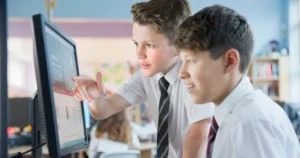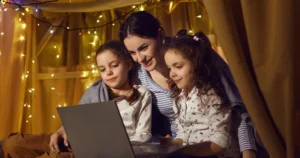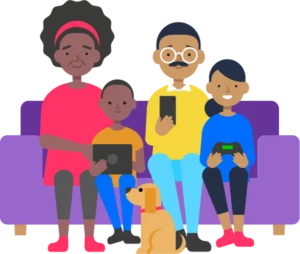Learn about our research into sexual image-sharing among kids aged 11 to 13 and what these insights mean for parents.
Summary
- What does sexual image-sharing among kids look like?
- What is self-generated abuse material?
- Our research into preventing sexual image-sharing
- How this research affects parents
- How to talk about sexual image-sharing with kids
- Resources to support parents
What does sexual image-sharing among kids look like?
Our research into sexual image-sharing among kids comes in response to alarming figures from the Internet Watch Foundation (IWF). IWF statistics reveal that the number of so-called ‘self-generated’ sexual abuse material has rocketed in recent years.
- Self-generated child sexual abuse material (CSAM) rose by 417% from 2019 to 2022 (38,500 to 199,00).
- 11-13-year-olds made up two-thirds of total cases of self-generated sexual imagery in 2022 (130,000).
- Girls featured in 97% of self-generated sexual abuse reports in 2022.
See the full 2022 report from the Internet Watch Foundation.
What is self-generated abuse material?
Self-generated abuse material is sexual imagery (pictures and videos) created by a child. They might use smartphones or webcams to create images before sharing them with others online.
The reasons children create this content varies. In some cases, adult offenders might coerce, deceive or manipulate children into sharing sexual images of themselves online. Or, children might share an intimate image consensually with another child. But someone else might share it further without their consent or knowledge.
Our research into preventing sexual image-sharing
We are conducting innovative research into effective prevention of sexual image-sharing among kids aged 11 to 13.
We currently know little about how to effectively prevent 11-13-year-olds from sharing sexual images online or pressuring others to do so. So, we’re working with panels of 11-18-year-olds, parents and professionals – including children with additional learning needs — to identify:
- An effective set of prevention messages for 11 to 13-year-olds. This messaging would support the needs of different groups of children, including boys and girls, and children with special educational needs.
- How best to target this messaging at children, either digitally or through schools.
4 issues we’ve identified so far
Children and teenagers are keen for more information and proactive advice on sexual image-sharing.
In the age of smartphones and social media, children are increasingly exploring relationships and intimacy in the digital world. Relationships and Sex Education (RSE) should equip children with the skills to navigate digital relationships. And this should include pressures to share sexual content online.
However, our panels suggest that RSE lessons are not cutting through. This is because:
- Teachers are often not subject specialists – they might lack training to deliver sensitive lessons.
- Lessons can feel rushed because teachers find the topic awkward and don’t know how to deliver it well.
- Classes are generally large (e.g. around 30 children) and mixed gender. Girls told us that boys often mess around and disrupt classes. As a result, girls don’t always feel safe or comfortable to share their views and experiences.
Without adequate classroom-based learning, children – in particular girls – are turning to their peers for advice. Advice from other children varies in reliability and safety.
Advice is often too little and too late.
Children told us that involvement from adults on image-sharing is often reactive. They said that parents and teachers generally only become meaningfully involved after an image is already shared and out in the world.
They told us that age-appropriate conversations should be more proactive. Discussions should come around the time they are given access to their own smartphone or device. This is when the pressure to share sexual imagery starts to build. For most children, this happens around the transition to secondary school.
Girls and boys face different pressures to create and distribute nudes.
Girls are more likely to feel pressure from boys to take and share intimate images of themselves. They gravitated to prevention messages about healthy and unhealthy relationships, and the impact of ‘negative attention’ online.
Boys, on the other hand, spoke to us about the ‘top down’ pressure from boys in older year groups to share sexual images of girls. They told us boys share or show each other girls’ images this to ‘prove’ themselves among male peer groups.
Boys responded more positively to prevention messages about resisting male peer pressure to receive and share girls’ nudes. Additionally, they responded well to messages around the legal and moral consequences of sharing sexual images.
Schools and tech firms likely need to use a range of delivery methods to reach children with consistent messages.
Our panels suggest that classroom methods still have a role to play in educating children about nude image sharing. Children see the value in a trusted adult delivering the session and sessions which encourage discussion and sharing. However, those delivering sessions should be well-informed and trained to deliver the topic
They also told us that digital routes (e.g. on-platform advice and nudges) will work to reach a large number of children with ‘in-the-moment’ prevention messages. This can help, especially if nudges lead out to signpost high-quality advice.
How this research affects parents
Parents and carers are crucial in supporting interventions to protect children from harmful image-sharing. A key way to do this is through constructive and ongoing conversations.
Our research into image-based abuse found that 13- to 17-year-olds were most likely to turn to a parent if they received an unwanted nude image or video. This shows that parents are the first port of call for most children when dealing with online safety issues. As such, it’s important for them to have the right tools to support their child.
How to talk about sexual image-sharing with kids
Conversations about image-sharing with kids should start early. Essentially, this is as soon as your child gets access to their own device or uses the internet unsupervised.
Start with a discussion about how hard it is to regain control of an image after it’s shared online. Then, start an open and honest dialogue, reminding your child that you won’t judge them and will always support them.
Different approaches for girls and boys
Our research suggests that different messages work for girls and for boys at the age of 11 to 13:
- Girls preferred messages about what healthy, respectful relationships should look like. This included what to look out for if someone pressures them into sharing images online.
- Girls also wanted reminders that not everyone does it (even though it may seem that way from social media or TV). In fact, our research shows that just 4% of 13-year-olds have shared an explicit image of themselves online.
- Boys wanted a direct reminder of the consequences of sharing intimate images. Sharing a sexual image of an under-18 is illegal, no matter the circumstances, and can involve the police.
- Boys also wanted more advice on resisting male peer pressure. They want parents and teachers to remind them that the results of giving into pressure can be much worse than standing up to it.
Supporting resources
We offer a range of resources for parents and carers to support conversations about a range of online safety topics, including sexual image-sharing.
Explore some of these resources below.







